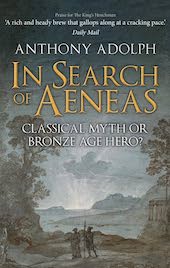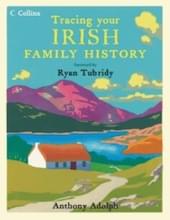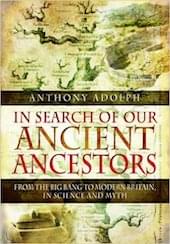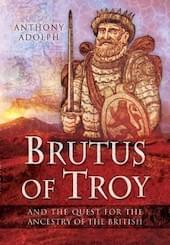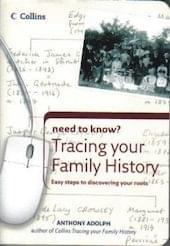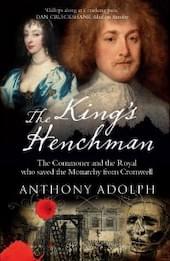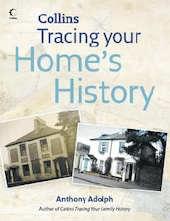THE KING’S HENCHMAN: The Commoner and the Royal who saved the Monarchy from Cromwell
Published by Gibson Square Books.

The new paperback cover
Revised and edited paperback, 3 April 2014, price £9.99, ISBN 978-1908096654
The précis for this book was shortlisted in the Biographer’s Club Prize in 2002. The book was first published privately in 2006 as Full of Soup and Gold: the Life of Henry Jermyn (ISBN: 978-0-9552951-0-2). It was then published in hardback by Gibson Square on 8 November 2012, as The King’s Henchman: Henry Jermyn, Stuart Spymaster and Architect of the British Empire, price £20, ISBN 9781908096302, and finally in paperback as The King’s Henchman: The Commoner and the Royal who saved the Monarchy from Cromwell, as detailed above.
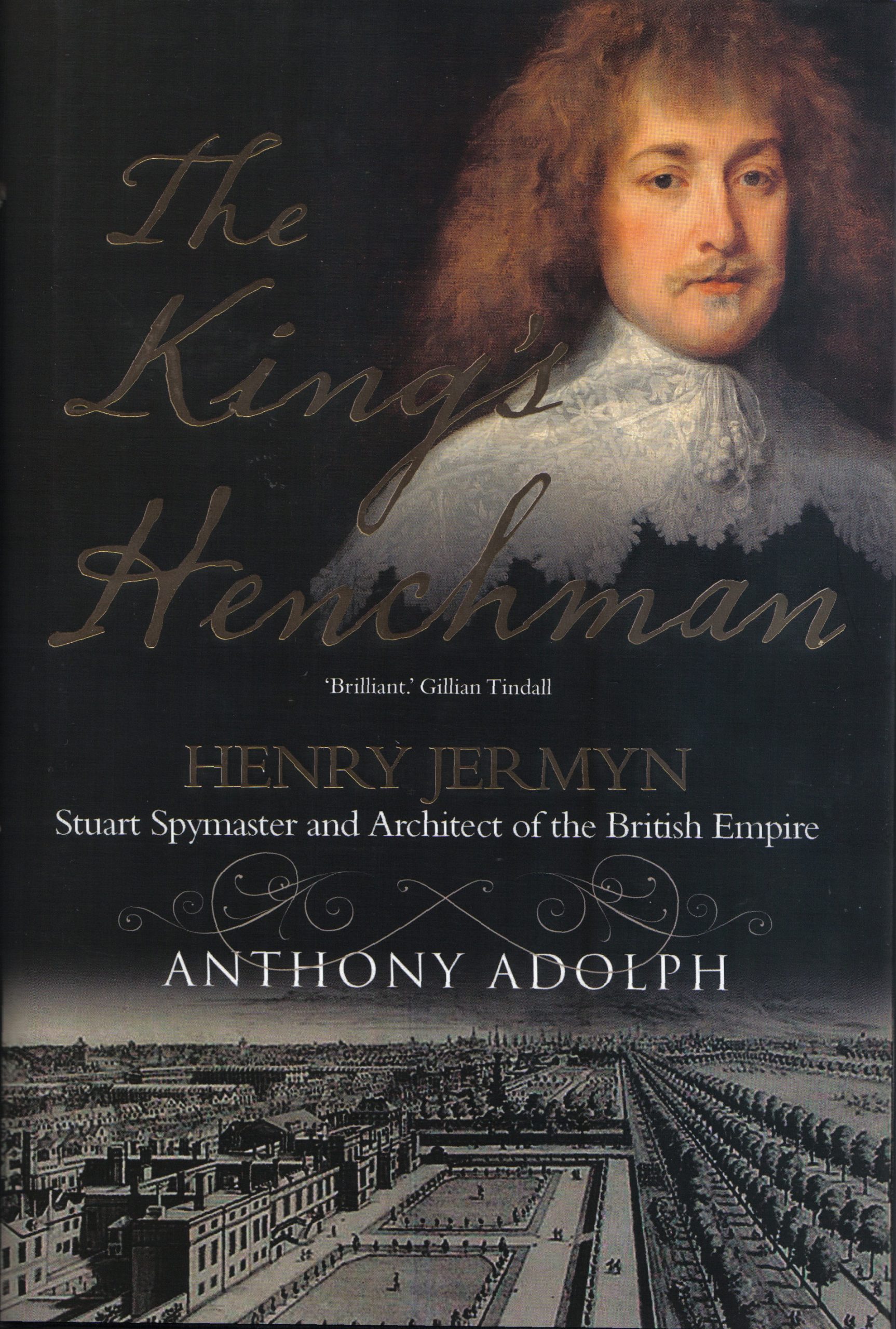
Title page of the 2012 hardback
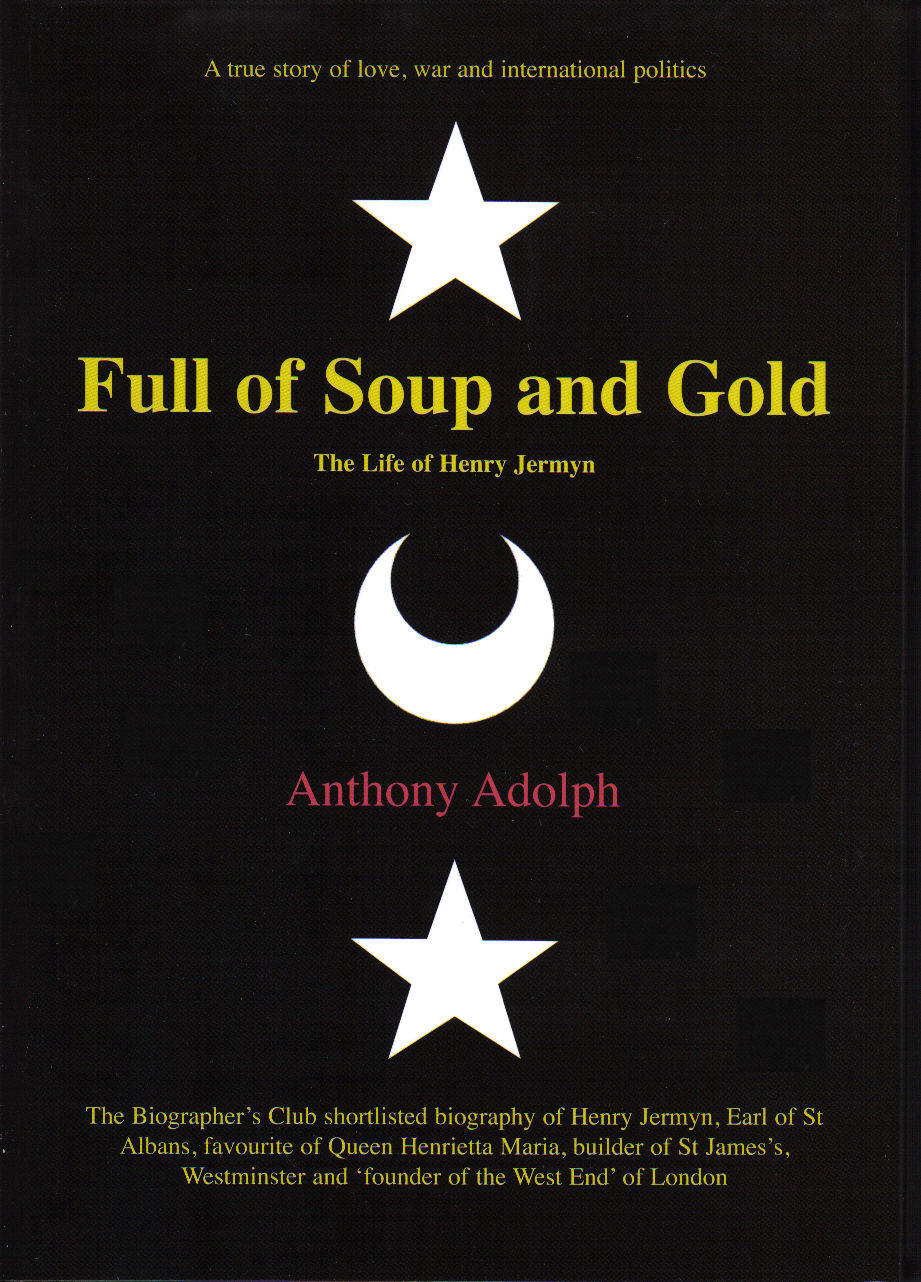
Cover of the original 2006 hardback
‘A rich and heady brew that gallops along at a cracking pace’ – Dan Cruickshank.
‘Energetic and original’ – The Literary Review.
‘A well-written book about an interesting subject” – Times Literary Supplement.
“… writes with passion and empathy for his subject”- Rosemary Haden.
One of the Daily Express‘s TOP NON-FICTION CHRISTMAS READS (7 December 2012)
‘Twenty years of research underpin Adolph’s accomplished and fascinating life of this intriguing character’, Your Family Tree, March 2013.
You can order the book using the book’s Amazon page.
I started researching this book in 1990, when I found a published statement saying that rumours of Henry Jermyn marrying Queen Henrietta Maria, widow of Charles I, could not possibly be true. I was curious to learn why not. Twenty two years later, the results of the vast amount of research and writing which ensued from that innocent question were published by Gibson Square, whose other authors include such luminaries as Richard Dawkins, Brian Sewell, Alan Greenspan and A.N. Wilson.
My interest in Jermyn led to the putting up of a plaque on the corner of St James’s Square, Westminster, to commemorate him, in 2011. I also started work on a biography of his nephew Harry Jermyn, Earl of Dover, that is yet to be completed.
About Henry Jermyn
Henry Jermyn (1605-1684) was a young Stuart courtier who, largely due to his skill in speaking French, became the confidant and life-long friend of Henrietta Maria de Bourbon, the beautiful wife of Charles I. Their closeness is widely attested by writers of the time, and some went so far as to assert he was the real father of Charles II. There is some evidence to suggest they may have been right. Below, you will see two pictures, one of Jermyn as a young man, painted by Van Dyck, and the other of Charles II at about the same age. The similarity is certainly worthy of note. But regardless of whether Jermyn actually was the King’s father, the fact that he could have been had a significant effect on the way Charles II and the rest of the royal family treated him.
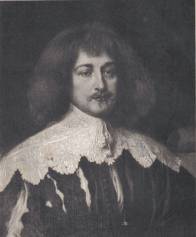

Through the Queen’s influence, Jermyn rose to prominence and power in Charles I’s court. Yet as his status increased, the foundations on which royal power lay were shaken by the King’s conflict with Parliament. As the crisis mushroomed in 1640-1, and without holding any significant office, Jermyn became the most powerful man at court. Yet his plot to bring military force to bear on Parliament backfired, and he fled into exile in France.
The Civil War began and Henrietta Maria (pictured below) joined him abroad. Together, they raised a great army, and, risking near death in a terrible storm, they sailed back to England to wage a moderately successful campaign against Parliamentary forces. In 1644, when the Queen became pregnant again, they returned to France, setting up their home, and hence the unofficial power-centre of the English court, at the Louvre in Paris.

During the rule of Cromwell, Jermyn worked ceaselessly to restore Charles II to the throne and was the driving force behind the ‘Second Civil War’. As life on the Continent became ever harder for the exiled Royalists, however, factions developed and Jermyn’s Louvre circle eventually lost power to the Chancellor, Edward Hyde.
After the Restoration of 1660, Jermyn made a final bid to oust Hyde from power in 1663. Being unsuccessful, he focussed on his life-long plan of creating a lasting peace between England and France. Parts of Jermyn’s plans were sucessful, including the marriage of Charles II to Catherine of Braganza, daughter of France’s ally the King of Portugal – a marriage that brought England Bombay, and thus laid the foundations for Britain’s empire in India. The Secret Treaty of Dover (1670) created the Anglo-French Grand Design, a temporary fulfilment of his aims, and a massive political achievement for Jermyn. His efforts to preserve this great alliance, however, in the face of enormous Francophobia at Court, would dominate the rest of his life, though ultimately Charles II was to end his days in a firm alliance with his cousin Louis XIV for which Jermyn could take full credit.
Jermyn’s story takes place on a stage of glittering splendour, in the courts of Whitehall, St James’s, the Louvre and Versailles. His story is also a personal one, of struggle, failure and triumph. It is dominated by his utter devotion to one woman, Queen Henrietta Maria, making this book not just a book about the nature of political power and influence, but also an extraordinary love story.
Jermyn was also the patron of two of the greatest poets of his era, William D’Avenant and Abraham Cowley. Both their poems, especially the former’s mini-epic Madagascar, add unexpected shades to our understanding of Jermyn’s already beguiling personality. His great passion, however, was not books, but architecture. As a protégé of Inigo Jones, and future mentor of Christopher Wren, Jermyn was one of the most influential men in the popularisation of Classical architecture in Britain. The restoration of old Somerset House and the creation of modern Greenwich Palace and Greenwich Park both owe a great deal to him. His great work was St James’s Square and the surrounding streets, including Jermyn Street, in London’s Westminster. It was the first truly unified, residential square built on Classical lines in London, and it caused the growth of the West End of London, to the extent that Jermyn has justly been hailed as ‘the Founder of the West End’.
Jermyn’s passion for architecture associated him heavily with the Freemasons. Little is known of this shadowy organisation in the 17th century, but surviving sources are clear on one point: between 1660 and 1666, Jermyn was Freemasonry’s Grand Master. It is likely, in fact, that his Freemasonic links were of great importance to his pre-1660 anti-Parliamentarian plots, and there is no doubt, through his reforms, that he helped lay the foundations for the great success of Freemasonry in the 18th century.
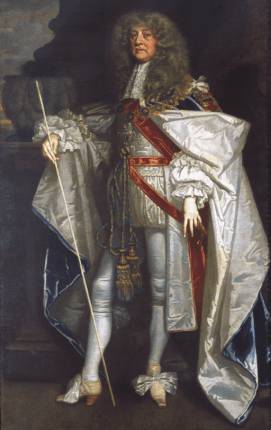
Sir Peter Lely’s great portrait of Jermyn, wearing his Garter Robes, and holding his white wand of office as Charles II’s Lord Chamberlain
Very few biographies can legitimately probe into their subjects’s lives after their death. An elegy written for Jermyn’s death, however, affords a rare opportunity to follow the journey of Jermyn’s soul on the next stage of its journey, in poetic terms at least, and to reflect upon the extraordinary nature of his life.
Jermyn’s enormous contribution to 17th century politics in Britain and abroad, and to the spread of Classical architecture, have largely been ignored. This is mainly because he left behind no archive of correspondence – it was far too sensitive to be preserved – and no self-congratulatory memoir. I spent a substantial chunk of the 1990s drawing together evidence about him from letters, official records, biographies and memoirs of his contemporaries in Britain and France. The précis for my biography of Henry Jermyn was short-listed in the Biographer’s Club Prize in 2002. A decade later, it finally appeared in print.
In 2023, I published The Collected Letters of Jermyn on this website, to aid further research into Henry Jermyn and his role in Britain’s 17th century history.
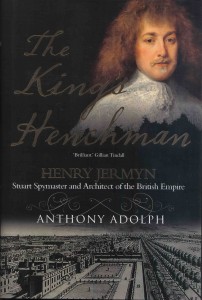
This is the cover of the original, hardback version, now superseded by the amended and edited paperback.
Praise for the book
The Mail on Sunday gave the book four out of five stars (16 December 2012).
Leading TV historian Dan Cruickshank wrote ‘The King’s Henchman is a good old-fashioned romp through history rather than a dry, academic study… a rich and heady brew that gallops along at a cracking pace’ (“Royal aide, or secret lover?”, The Mail on Sunday, 16 December 2012, p. 10).

Dan Cruickshank is one of the greatest living authorities on London’s architectural past, so his seal of approval meant a great deal. Dan’s summary of the story of St James’s is worth reproducing in full: ‘Inspired by the pioneering classical architecture of Madrid and Paris, Jermyn, with Henrietta Maria, resolved to create a similarly impressive area in London, and in 1640 started to survey the fields north of St James’s Palace. But it all came to nothing, for within two years England was gripped by a civil war that ended in death for Charles I and exile for Henrietta Maria and Jermyn. The couple spent more than a decade together in France, both returning to England in 1660, and less than two years later, Jermyn resurrected their cherished project and launched the development of St James’s Square. When Henrietta Maria left England for good in 1665, Jermyn pushed the project to completion: perhaps he saw it as a memorial to the woman he certainly loved and to whom – whether or not she was also his lover – he had dedicated much of his life’.
“Genealogist reveals royal scandal”, Canterbury Times, 8 November 2012.
“Cuckolding spy fathered 2 monarchs”, Sunday Express, 11 November 2012, half-page article, p. 34.
Talk, 14 November 2012, 7.30-10.30, “The King’s Henchman and Genealogy”, The Phoenix Tavern, Faversham, Kent (hosted by David Selves, Deputy Chairman of the London Press Club: previous speakers included Martin Bell and Nigel Farage).
“A cavalier attitude to monarchy”, review by Blair Worden in The Spectator, 17 November 2012. Prof. Worden wrote ‘Adolph does have a visual feel for the age and a rare gift for conveying it, virtues which prosper in his depiction of his hero’s imaginative sponsorship of the building of Jermyn Street and St James’s Square on scruffy London fields’.
Professor Worden pronounced himself unconvinced by my overall argument that Jermyn was an immensely influential figure in seventeenth century politics who had been overlooked by most historians (including Professor Blair Worden) so The Spectator published a letter from me setting the situation straight:
“Cavalier treatment“, letter from Anthony Adolph, The Spectator, 1 December 2012.
The Spectator also commissioned a piece by me for their journalists’ blog:
“Henry Jermyn – the hidden power behind Charles II’s throne“, Anthony Adolph, The Spectator blog, 4 December 2012.
The Daily Express‘s TOP NON-FICTION CHRISTMAS READS, chosen by Christopher Silvester (7 December 2012, p. 51) included the book (see Make a present of cracking tales from our past), saying “Genealogist Anthony Adolph has chosen a fascinating, shadowy figure in Henry Jermyn as the subject of his first biography, The King’s Henchman: Stuart Spymaster And Architect Of The British Empire (Gibson Square Books, £20). Adolph has been studying Jermyn for 20 years and is convinced that he was the lover of Charles I’s French Catholic queen, Henrietta Maria, as well as one of the saviours of the British monarchy, through his negotiations with Parliament to restore Charles II to the throne, and a saviour of the nation through his diplomacy that averted a war with France. He was certainly well connected for a commoner and had his finger in many pies, deserving Adolph’s accolade as founder of London’s West End…”.
‘I am enjoying The King’s Henchman very much. Your narrative style is so clear, it makes the story both comprehensible and entertaining at the same time’ – Paul Bartlett PhD, founder of the Coverdale DNA project, January 2013.
Noticed under “The bastard kings?” in Your Family Tree, February 2013, p. 10 and reviewed in the magazine’s March edition, p. 85 as follows (and my sincere thanks go to the anonymous author): ‘Anthony Adolph is well-known to YFT readers for his monthly guides to surnames and quite possibly for his excellent series of genealogy textbooks published by Collins. In recent years he has also taken to writing biographies… This new work now explores Jermyn’s life in much more detail and is the first full biography. Why should Jermyn be given such treatment? He has certainly been neglected, but clearly unjustly. It has been speculated that he was actually the father of Charles II and James II, and in this book Adolph explores that claim and also asserts that Jermyn was the architect of the British Empire and even the father of modern town planning. Jermyn represents a worthy subject of such study: a commoner from Suffolk who rose to the highest levels of connection, he was a soldier and spymaster who was friends with many key figures of the age, from the famous diarist Samuel Pepys to Cardinal Richelieu. Twenty years of research underpin Adolph’s accomplished and fascinating life of this intriguing character. Read it for: A story of a major, but neglected figure, who rose through the heights of society’.
The book was noticed in St George’s College Reunite magazine, Winter 2012, p. 47.
Described as ‘something meaty’ in The Belgravia Residents’ Journal, March 2013, issue 10.
‘energetic and original…. a rich sense of place… Jermyn’s contribution to what John Evelyn called “a renaissance in English classical architecture, and his championing of symmetry and Sir Christopher Wren, are justifiably emphasised. Adolph switches to the first person to tell us about the commemorative plaque that he mounted on the wall of Chatham House, a gesture of thanks to the man who has given him so much fascinating material to research. Few biographers of the long-dead feel quite so strong a connection with the people they write about. Anthony Adolph could hardly have done him more justice’ – John Cooper, author of The Queen’s Agent, in his review of my book entitled ‘Power Player’, The Literary Review, March 2013, p. 29.
The book was included in a number of radio and TV interviews at the time of the birth of H.R.H. Prince George of Cambridge in July 2013.
The book was reviewed by Michael Braddick (Professor of History, Pro-Vice-Chancellor for the Faculty of Arts and Humanities at Sheffield University) in the Times Literary Supplement (“Scrapes and rumours”, 2 August 2013, p. 23). “Henry Jermyn is clearly an enticing subject for a biography… Anthony Adolph is well placed to write the biography, having produced the judicious and learned entry in the Oxford Dictionary of National Biography… a well-written book about an interesting subject”.
“A well-researched account of Henry Jermyn’s contribution to British history. The author writes with passion and empathy for his subject and the result is a very readable and enjoyable text. Highly recommended” – Rosemary Haden”, in The Book Depository website, June 2014.
“I read your book with great interest and enjoyment”, Claire Letemendia, author of The License of War (2014), a novel set during Jermyn’s period.
Cited in “Richard Lovelace: Royalist Poetry in Context, 1639–1649” by Susan Alice Clarke in a thesis submitted for the degree of Doctor of Philosophy of The Australian National University, July 2010: “David Norbrook, Nigel Smith and Blair Worden all helped with information. Daniel Lovelace and Anthony Adolph provided copies of their biographies of Francis Lovelace and Henry Jermyn”.
The Adventures of Henry Jermyn
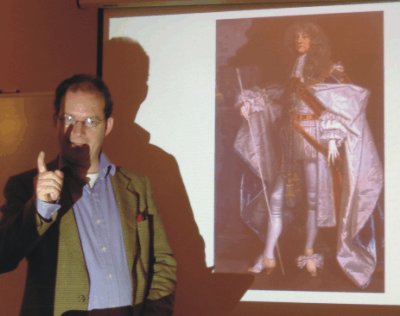
Jermynology: how genealogy can change history: The Ancestors Lecture, Ancestors Afternoon at the National Archives, Thursday 22 February 2007.
 Henry Jermyn and the Jermyns of Rushbrook.
Henry Jermyn and the Jermyns of Rushbrook.
Talk on 13 May 2007 at Moyse’s Hall Museum, Bury St Edmunds, during the Bury St Edmunds Festival. The talk was a marvelous opportunity to take Jermyn back to where his family originated, for the Jermyn family seat of Rushbrook is only three miles south-east of the market town of Bury St Edmunds, and his first title, granted by Charles I at Henrietta Maria’s behest, was Baron Jermyn of St Edmundsbury.
Amongst the enthusiastic local audience was a lady who grew up in the gatehouse of Ruhsbrook and remembers watching through the curtains as a six year-old girl as the old mansion, where Jermyn grew up, burned down in 1960.
The world’s oldest identifiable wine bottle?
In June 2007, Paul Gaskell, was on holiday in Jersey and noticed a piece in the Jersey Evening Post(30 May 2007) that mentioned Henry Jermyn. Since the 1920s, Mont Orgueil castle’s museum has on display a wine bottle that had been stamped (whilst it was being made) with the Jermyn family’s seal, thought to date from the 1640s. They had thought no more of it, until recently they were contacted by Professor Martin Biddle of Oxford University, who told them ‘if it belongs to Henry Jermyn’s first governorship (1644-9), it would be the earliest dateable wine bottle’. There are of course other wine bottles that must be considerably older than this one, but as they are uninscribed they cannot be dated accurately. The fact that this one has Jermyn’s arms on it, and the Jermyn family’s tenures as governors of Jersey are very well chronicled, makes this an extraordinary find. I was delighted to see Jermyn’s name in the press, and on 18 July the paper published the following communication from me, under the title “1645… A Governor who liked his wine”:
I have just been sent your piece about the early wine bottle found at Mont Orgueil, which may be ‘the earliest known datable wine bottle’. I must say, I almost fell off my chair when I read it, because I have just written and published the first ever biography of its possible owner, Henry Jermyn, Earl of St Albans (1605-1684).
The bottle may or may not have been Henry Jermyn’s, because it is identifiable only by his family’s coat of arms, and as you know several members of his family held the office of Governor of Jersey. The first was actually his father, Sir Thomas Jermyn (1573-1645), who became governor on 22 December 1631, with special dispensation to avoid the tedious necessity of having to live there. His son Henry was a very close friend of Charles I’s queen, Henrietta Maria, and may actually have had an affair with her. After this Henry had an affair with one of the Queen’s maids of honour, for which he was exiled briefly to Jersey in 1634. He inherited the Governorship himself when his father died in 1645 and paid a very grand return visit there in 1646, to escort the young Prince of Wales, the future Charles II – who may actually have been his son – back to Paris.
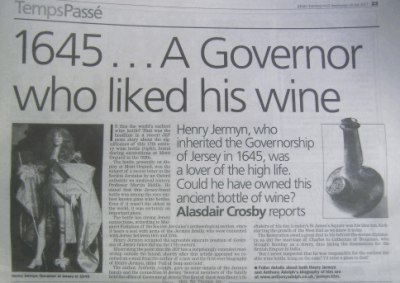
The wine bottle could therefore date back to 1631: if it is thought unlikely that an armorial wine bottle would have been there in the absence of a Jermyn in person, then I can certainly give you 1634 as a possibility. It certainly wouldn’t surprise me at all if the bottle was Henry Jermyn’s. The title I gave the first edition of my biography of him, Full of Soup and Gold, is from a contemporary poem alluding to his inordinate love of the high life – wine, female company and food – which marked him out even by the sozzled standards of Charles II’s day.
Henry Jermyn was one of the great movers and shakers of his day. London’s St James’s Square was his idea too, kick-starting the growth of the West End as we know it today. The Restoration owed a great deal to his behind-the-scenes diplomacy, as did the marriage of Charles to Catherine of Braganza, that brought Bombay as a dowry, thus laying the foundations for the British Empire in India.
But I never suspected that he was responsible for the earliest datable wine bottle. Icing on the cake? I’d raise a glass to that!
Further adventures
The appearance of this article led to an interview on BBC Radio Jersey on 25 July 2007. Initially planned at 10 minutes, it lasted for a full 25 minutes as presenter Sarah Palmer (who was born in Bury St Edmunds and lived in St Albans before moving to Jersey – three Jermyn connections in all) enthusiastically asked all about Jermyn’s connections with the island, his involvement as a Freemason and of course the love of soup and gold that led to Jermyn owning the world’s oldest wine bottle.
My work on Jermyn received a considerable boost from Dr Maureen E. Mulvihill, a respected scholar, author, and rare book collector with the Princeton Research Forum, Princeton, New Jersey. She has written extensively on the subject of Mary (Villiers), Duchess of Richmond (“very probably” the long-contested ‘Ephelia’ poetess), who was a member of Jermyn’s circle. Her assessment of my Jermyn delvings appeared in the journal Seventeenth-Century News (65, 3 & 4, 2007) and was accompanied by a full-page captioned photo of Lely’s 1670 Garter portrait of Jermyn.

On 19 May 2008, I was invited to give my Jermynology talk in Oxford. This was another ‘return journey’ for Jermyn, who marched into Oxford with Henrietta Maria at the head of their regiment, the Queen’s Lifeguards, on 14 July 1643. It was an occasion for great rejoicing, they for having arrived safely, and the Royalists for their money, troops, gunpowder, French officers and morale. The King was lodged in Christ Church, but they set up their own establishment over the road at Merton College (whose gateway is pictured below)and stayed there through the winter and into the spring. The tide of war was turning, however, and the pregnant queen, terrified that the approaching army of Lord Essex would capture her and her unborn child, insisted on leaving for France. She and Jermyn left in April 1644, neither to see Charles I again.
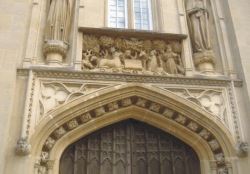
Jermynology: case studies in Royal Bastardy, a talk given at the Society of Genealogists on Saturday 21 August 2010, as part of the Society of Genealogists’ half-day course “Tracing Royal Bastards”. The other talk was a general one on the subject of royal bastardy by Peter de Vere Beauclerk-Dewar, a grandson of the late Duke of St Albans, and thus a descendant of the first duke, son of Charles II and Nell Gwyn, who was given the title of duke with the territorial designation of St Albans within days of the death of Jermyn, who had been Earl of St Albans. The Jermyn talk focussed on four questions of illicit conceptions and marriages: possible marriages between Jermyn and Henrietta Maria and Harry Jermyn and Mary of Orange; the possibility that Charles II was Jermyn’s son, and the possibility that the first Duke of Grafton was the son of Harry Jermyn, and not of Charles II.

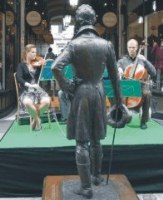
(Left) Speaking about Jermyn at the Society of Genealogists. (Right) The Jermyn Street garden party
Exactly two weeks later, I was invited to give a talk for the press at the Cavendish Hotel, Jermyn Street, at the start of the Jermyn Street Association’s “The Art of Being British” garden party. The talk, Jermyn of Jermyn Street, focussed on Jermyn’s creation of Jermyn Street – which was visible through the window – and its environs. It was a great pleasure to give the talk there, so intead of saying “he finished Jermyn Street in 1666”, I could say “he finished this street in 1667″, and to see pictures that had one belonged to Jermyn being displayed on a projector-screen within yards of where they once hung, in his house in St James’s Square. The talk was followed by a champagne and cheese tasting at Paxton & Whitfield, who have been selling cheese in Jermyn Street since 1797, shortly after 81 Jermyn Street first became the hotel that later grew into the Cavendish. My sincere thanks to those kind denizens of modern Jermyn Street who made a very interesting and successful day possible.
Some of the Jermyn family’s interesting connections appear at this page. Created by William Allen Shade, it shows that the descendants of the Jermyns of Rushbrook include Lord Nelson, another great naval commander, Earl Howe (d. 1799, via the marriage of Susan Jermyn to Sir Lionel Tollemache, and down to the Allingtons and then the Howes) and, more surprisingly, explorer and television presenter Edward Michael ‘Bear’ Grylls (via the 4th Earl of Bristol’s daughter Mary Caroline, Lady Erbe, whose daughter Elizabeth, Lady Wharncliffe was mother of Caroline Chetwynd-Talbot: her son Edward was mother of Mrs Mary Ford, mother of Neville Montagu Ford, whose daughter Sally, Lady Grylls, was ‘Bear’ Grylls’ mother). The youngest British person ever to climb Everest, he can certainly be considered a worthy relative of Henry Jermyn.
In July 2019, Henry Jermyn made a rare appearance on television in BBC 4’s ‘Charles I: Downfall of a King’, a three-part series charting the collapse of Charles I’s power in the 50 days leading up to the declaration of Civil War in 1642. Jermyn himself was at that time in exile in France, having had to flee the hands of Parliament earlier in 1641 due to his part in the Army Plot (that had aimed to quash the rebellious stirrings of Parliament altogether). He therefore featured very little, but the series’ producer, Tom Cholmondeley, had read The King’s Henchman and was keen to include a little of his story. In episode three, therefore, a good five minutes was devoted to the way Parliament, keen to use every lever it could against the King, talked up the rumours that Queen Henrietta Maria and Henry Jermyn were lovers, and that Jermyn was the real father of Charles I. The sequence included an interview with me (spit into two chunks) by presenter Lisa Hilton, and some good footage of the plaque I had put up to Jermyn in St James’s, his portrait by Van Dyck, and a page from the State Papers in which some of the rumours were recorded. It’s a shame the program could not also cover Henry Jermyn’s part in the events leading up to the last 50 days, or the way, just after the program ended, Henrietta Maria would flee to Holland, to be joined immediately by Jermyn and how, together, they raised a great fleet and army to help the King fight the Civil War. But the fact that Henry Jermyn received some prime-time air-time at all was, I felt, an achievement.
Articles by Anthony Adolph about Jermyn
“Rushbrook’s Forgotten Hero”, Suffolk and Norfolk Life , 10 no. 109 September 1998 pp. 12-13.
“Henry Jermyn and the Creation of Greenwich”, Bygone Kent 19 no. 10 pp. 613-617.
“Weybridge, Oatlands and Byfleet: Domain of the Earl of St Alban”, Surrey County Magazine, October 1998, pp. 34-5.
“Henry Jermyn, Grand Master of the Freemasons?”, Freemasonry Today, issue 6, Autumn 1998 p. 46.
“Founder of the West End? Henry Jermyn and the Development of St James’s, Westminster”. Westminster History Review, no. 2, 1999, pp. 13-18.
“Jermyns, Stuarts and Webbers: Three Tales of Bastardy”. Family History¸ 19, no. 160, n.s. 136, July 1999, pp. 337-348.
“The Earl of St Alban’s, The Marquess of Antrim and the Irish Acts of Settlement and Explanation, 1660-1684”, The Irish Genealogist, vol. 10, no. 2, 1999, pp 234-240.
“A Forgotten Cornish Courtier”, Cornwall Today, February 2000.
“Henry Jermyn, (1605-1684), Earl of St Alban, K.G., Governor of Jersey”, Société Jersiaise, Annual Bulletin for 2000, 27(4), pp. 636-652.
“Henry Jermyn: the genuine genius of Greenwich”, The Maritime Yearbook (Friends of the National Maritime Museum), no. 8, 2000/2001, p. 53.
“More Rushbrooke Jottings”, Readers’ Letters, Suffolk Roots, May 2001, pp 53-4.
“‘….and in my lady’s chamber’, Jermyns and Stuarts: illicit liaisons”, Genealogists’ Magazine, vol. 27, no. 7, September 2002, pp 300-305 (supported by a letter by Lesley Jarman in the March edition, ‘Henry Jermyn and Charles II’). This was cited in W.M.Roberts, Lost Country Houses of Suffolk, Boydell Press, 2010, pp. 137, 209.
“‘Henry Jermyn , creator of the church and parish of St James’s, Westminster”, on the website of St James’s Church, Piccadilly (St James’s Piccadilly website).
Cavalier Queen
‘I liked Eleanor well enough. There are plenty of other pretty girls I like well enough. But I will not settle for someone I can live with, when I have found someone I cannot live without. I am willing to remain a bachelor all my life, so that I may devote myself to your service.’ In these beautiful words, spoken to Queen Henrietta Maria, Jermyn summed up his entire life.
This quote is not from an historical source, but from a new novel, Cavalier Queen, written by Fiona Mountain and published in September 2011. Fiona Mountain explains how my work on Henry Jermyn inspired her to write her novel: “I was nearly half way through the first draft of an entirely different story about the Civil War when, during the course of my research, I came across Anthony’s wonderful work. As soon as I started reading, it sent tingles down my spine. It is the kind of story any historical novelist, who writes books based on real people and facts, dreams of discovering. I realised I was writing entirely the wrong novel, and that here was a far more exciting tale just begging to be told. It was an incredibly exciting, eureka moment! However it was with some trepidation that I approached my agent and editor and told them that I absolutely had to scrap the first book and start afresh! But they both agreed with me when I said that the story of Henrietta Maria and Henry Jermyn is pure dynamite! An incredibly moving and dramatic love story set in the midst of one of the most cataclysmic events in our history. I could not believe that it had not been fictionalised before. Henry Jermyn is a wonderful character largely forgotten by history – until Anthony and then I resurrected him – who has played such an important role in shaping both the history and architecture of England. For a novelist, such a character is the find of a lifetime. I am grateful to Anthony for finding him first!

I have already read Cavalier Queen and cannot recommend it too highly. I managed to rediscover Henry Jermyn from a collection of old documents and references, but now Fiona has made him into a real character, and rather a romantic hero – the romantic hero that he actually was in real life. For more information, see Fiona’s website, www.fionamountain.com.
The Oxford Mail reported an interview with Fiona Mountain (28 October 2011, ‘From rock chick to best-selling author’) in which she said, ‘Henrietta’s love for the Charles I is one of the most famous love stories in history. But there were contemporary rumours that she and Henry were lovers’. She was 100 pages into her book, after eight months of research, when she read Anthony Adolph’s biography of Henry Jermyn. She added: ‘It led me to abandon what I had written completely. I realised I was writing the wrong story. I needed to tell the story of Henrietta and Jermyn. I just could not believe that it had not been told before’.
‘As soon as I found [Henry Jermyn] in Anthony Adolph’s biography, it sent tingles down my spine. It is the kind of story any historical novelist, who writes books based on real people and facts, dreams of discovering’, Fiona Mountain, interviewed in Your Family Tree (December 2011, issue 110, p. 82).
Some Reader’s comments
Dusting off ol’ St Albans – shining & dignified, at last – Maureen E. Mulvihill, historian
You have made a substantial revision of 17th Century British History, but clearly on the basis of sound and professional work – and very impressive it is – Dudley Woodget (former A-level History teacher)
… an astonishing book & very remarkable piece of research. Thank you. I read it in one sitting – couldn’t put it down – Lesley Jarman, Essex
Anthony my impression was one of color. You write so well. You made everything so real right down to the liver spots on his skin – Sheila Le Sueur, Arizona.
I opened it on its arrival and was immediately taken by it, to the extent that I laid aside the book that I was then reading and looked at no other until I had finished yours. The fascination for me was not only in the life of Jermyn himself, of whom I had previously known little, but in the picture you paint of the court and diplomatic life of the period… Thank you again: a tour de force!– Richard Havers-Strong, France
Reviews
… a passionately committed and scholarly study of one of the Stuarts’ more illustrious henchmen, complete with detailed notes on sources that have never previously been brought together…. Anthony Adolph’s book has not been through the usual publishing mill because he has had to publish it himself, and he has made a very good job of it… How many of those who, today, buy expensive shirts and shaving brushes in Jermyn Street know to whose taste and indomitable enterprise we owe the street itself? Let’s hope this book is on sale there too! – Gillian Tindall, “West End Wonders”, Literary Review, June 2007, pp. 47-8.
… Adolph tells his story with customary aplomb, and the book demonstrates his meticulous research – Your Family Tree, May 2007 p. 83.
… thousands of hours of hours researching – to impressive effect, Family History Monthly, July 2007, no. 145, p. 53.
… an enjoyable biography of a rollicking life, full of politcs, scandals and love affairs, Ancestors, August 2007.
Full of Soup and Gold was reviewed by Maureen Mulvihill, Princeton Research Forum, Princeton, New Jersey, in Seventeenth Century News, Fall-Winter 2007, vol. 65, nos 3&4, pp. 107-112. The full text is given below.
Notice of the book (by Maureen Mulvihill) was published in Restoration, Spring 2008, p 4.
The book was recommended (as ‘excellent’) by Tom Otley, editor of Business Traveller(February 2011).
The book and the life of Jermyn were promoted in “The Life of Henry Jermyn, creator of St James’s), in the St James’s Conservation Trust Newsletter, July-December 2010, edition no. 13.
The book was cited on the website of London picture dealer Miles Barton, concerning the identification of the portrait of a young man by Weesop as Thomas, 2nd Baron Jermyn.
Full of Soup and Gold received an extensive and woefully inaccurate review in The Genealogists’ Magazine by Roger S. Powell in November 2007. This was reposted, roundly, by a letter from me in The Genealogist’s Magazine, March 2008, pp. 194-5. Mr Powell had taken the opportunity of being asked to review my book to plug his own, which, he asserted, gave a better theory than mine on the identity of Harry Jermyn’s child by Barbara Villiers. His book does nothing of the sort, merely presenting a very cautiously-worded theory that their child may have been Dame Cecilia Fitzroy, but admitting that our knowledge of her year of birth was very vague indeed. It is not a theory that stands up to any scrutiny: the evidence for their child having been the 1st Duke of Grafton, as presented in my book, is much firmer.
Seventeenth-Century News
This is the full text of the review of Full of Soup and Gold by Maureen Mulvihill, Princeton Research Forum, Princeton, New Jersey, in Seventeenth Century News, Fall-Winter 2007, vol. 65, nos 3&4, pp. 107-112:
(http://www-english.tamu.edu/pubs/scn/)
“Revisionist biographers must be master picklocks. Their impulse is discovery, finding new truths; and their tactics of detection must be bold, shrewd, and imaginative. Rectifying historical error and re-representing their subjects, biographers of this persuasion blow off the dust of centuries. They collect new evidence; they draw fresh inferences; and they (inconveniently) upend traditional views. Reliable revisionist biographers, those who delve with care and good judgment, reorder long-held opinions, and we are in their debt for the alterations they make in our perception of an individual life and the forces which shaped the character and the arc of that life.
“Cometh the hour, cometh the man. Welcome, Anthony Adolph, who brings to seventeenth-century studies the first-ever biography of a principal, though unstudied and much maligned, Stuart statesman: Henry Jermyn (c.1604/ 1605; d., 1684), first Earl of St Alban (investiture, 1672). Adolph’s biography was a short-list nominee for The Biographer’s Club Prize; and while the book is (oddly) a self-published venture, it valuably received close vetting and guidance by many distinguished specialists and peers named in the volume’s Acknowledgments: Earl Bathurst, Malcolm Smuts, Ronald Hutton, et al. (283).
“Well up to the task, Adolph is a student of seventeenth-century history (training: Durham University and The Institute of Heraldry and Genealogical Studies, Canterbury) and also a professional writer, genealogist, and TV and radio broadcaster (see Adolph’s website, referenced at the close of this review). His broad, interdisciplinary skills supplied several good lenses through which he examined a large, complex body of uncollected material on his subject. Most students of Stuart court culture and seventeenth-century English political history are but vaguely familiar with Henry Jermyn. While they appreciate that he was a pervasive presence and faithful royalist during the administrations of Charles I and Charles II, the typical view is that of a man who achieved more than his wit and talent allowed. Adolph has done an important service for history by swivelling the focus altogether. He counters the vilified view of Jermyn with a substantial body of new facts and inferences which enable him to convincingly reconfigure (indeed, radically reconfigure) his subject’s character and achievements. Adolph presents Jermyn as a capable, energetic personality, especially during Jermyn’s glamorous youth at the first Caroline court, where he secured his reputation and status as the acknowledged favorite and confidant of Queen Henrietta Maria. In his black satin suit and white boots, Jermyn cut a stylish figure, and Van Dyck’s portrait of a youthful Jermyn (62) captures something of his early vigor. But the man’s singular talent, as Adolph shows over some 24 densely supported chapters, many with excellent images, was the courtly arts of intrigue and diplomacy. Adolph’s Jermyn is a man of parts, and Jermyn’s long rèsumé lists several critical roles during the turbulent seventeenth century: chief financial administrator and household steward to Queen Henrietta Maria; administrative principal during the long Stuart exile of the Queen’s coterie (‘the Louvre group’, mostly English Catholics); and after the Stuart restoration in 1660, Lord Chamberlain to Charles II, who assigned Jermyn (then into his sixth decade, nearly blind and crippled by gout) the sensitive task of opening negotiations with Louis XIV’s ambassadors–talks which importantly led to the secret Treaty of Dover (May, 1670).
“Yet, for all of Jermyn’s contribution to domestic and foreign affairs, not to mention his devoted care of Queen Henrietta Maria, dating from about 1624 to her sad death in 1669, his reputation was nastily smeared by Puritan propagandists, by jealous court satirists, and by Clarendon, a principal antagonist. It fell to Andrew Marvell, in his scathing satire on the conduct of the Dutch Wars, Last Instructions to a Painter (September, 1667), to famously fix Jermyn in the historical record as a dissipated opportunist, gambler, and roué a man who had outlived his usefulness in the boneyard of obsolete power brokers:
“Paint then St Albans full of soup and gold,
The new court’s pattern, stallion of the old.
Him neither wit nor courage did exalt,
But Fortune chose him for her pleasure salt.
Paint him with drayman’s shoulders, butcher’s mien,
Member’d like mules, with elephantine chin.
Well he the title of St Alban’s bore,
For Bacon never studied nature more
But age, allaying now that youthful heat,
Fits him in France to play at cards and treat.
(G. de F. Lord et al., eds., Poems on Affairs of State,
1 [1963], 100)
“Marvell’s Jermyn is the pompous and unattractive subject in Lely’s garter portrait (1674), the man whom ol’ ‘Harry’ Jermyn invariably became in his declining years. Sadly, this soiled and unjust image is the one that has remained, even amongst the publishers whom Anthony Adolph approached, evidently. And while C H Firth’s perfunctory essay on Jermyn in the earlier DNB series (1891) is now justly superseded by Adolph’s, there is no denying that Henry Jermyn has taken quite a pasting over the centuries.
“While never valorizing his subject, Adolph’s book on the life and times of Jermyn valuably balances the record: Adolph admits to his subject’s vagaries (his seduction and consequent indifference to the pregnant Lady Elizabeth Villiers was but one of many high-profile peccadilloes), but Adolph foregrounds Jermyn’s political skills and his subject’s faithful assistance to the Stuart monarchy before and after 1660. Thankfully, this is not a modish psychobiography (Adolph is no ‘pathographer’, nor would his source-materials allow such latitude); this is a responsible repositioning of an important political figure in seventeenth-century English history, drawn mainly from a broad range of interdisciplinary sources. In his role as a responsible revisionist biographer, in this case, Adolph handsomely serves three masters, really: biography, history, and also genealogy; the book’s closing chapter includes three pedigrees of Adolph’s own personal construction (262-267), representing Jermyn’s paternal line, his maternal line, and the Bourbon-Stuart line which played so large a part in Jermyn’s life and long career.
“There are two facets of Jermyn’s biography which Adolph manages with special care. First is Jermyn’s special relationship to Queen Henrietta Maria, dating from the 1620s. Restoration gossips and memoirists, and especially Puritan scandalmongers, roundly asserted that Jermyn’s power and rise to the nobility were not earned, but all the Queen’s doing; rumor also had it that one of the great open secrets of the century was the quiet ‘marriage’, after 1649, between Henrietta Maria and Jermyn; and according to a tantalizing bit of spin in Pepys, a child resulted from this union. Adolph confirms that this long, affectionate union did in fact exist between the Queen and Jermyn (morganatic marriages were not uncommon at this time, especially on the Continent), but he deduces that theirs was very probably a “chaste, Platonic” bond. Adolph does suggest, however, in a masterful essay in the Irish Genealogist, volume 10, 1999, that Pepys’s throwaway comment on illegitimate issue from this union, alongside other garbled versions of Pepys’s court gossip, suggests at least Pepys’s suspicion of bastard issue from this union and also that the child was quietly taken in and bred up by the Queen’s favorite lady-in-waiting and adoptive daughter, Mary Villiers, later Stuart, Duchess of Richmond (very probably the ‘Ephelia’ poetess); and furthermore that the child, as Adolph puts it, may have ‘masqueraded’ as Mary Stuart, later Butler, Countess of Arran (1651-1668), daughter of the Duchess of Richmond and her husband, James (Stuart), Duke of Richmond. This view gains credibility in light of the strenuous and successful attempts by the Duchess’s only living brother, George Villiers, second Duke of Buckingham, to disinherit the Duchess’s ‘daughter’, an action entirely sensible had she not been legitimate issue of the Villiers bloodline.
“And then there is Jermyn’s little-known link to the English order of the Freemasons, an association suggested by the activities and disposition of Jermyn’s coterie, by Jermyn’s work in urban planning, by James Anderson’s history of the Craft (Constitutions of the …Masons, compiled with the authority of the Grand Lodge, London, 1723, 1738, 1746), and by Jermyn’s own choice of title upon his elevation to the peerage in 1659: Earl of St Alban, St Alban being the legendary founder of English masonry (180-187, with images; 256-259). It appears that Jermyn maintained a distinguished niche in the London order of the Freemasons, rising to the elected administrative role of Patron and also Grand Master (1660-1666). The seventeenth-century English brotherhood of Freemasons was the Mensa group of its day: an élite and clandestine society of cultured and forward-looking individuals, whose agenda promoted Classical ideals in the trades (especially architecture), as well as tolerance, benevolence, and human improvement. Its distinguished (elected) membership included Sir Francis Bacon, Elias Ashmole, Sir John Denham, Sir Christopher Wren, Inigo Jones, Sir Robert Moray, George Villiers second Duke of Buckingham, Thomas (Savage) third Earl Rivers, Henry (Bennet) first Earl of Arlington, Charles II, et al. Jermyn’s work in Masonic circles is visible down to the present day in his principal achievement: the design of St James’s Square and surrounding streets, including Jermyn Street in London’s Westminster. As Adolph emphasizes, this was the first truly unified, residential square built on Classical lines in London, and it led to the growth of the West End of London, to the extent that Jermyn has justly been hailed ‘the Founder of the West End’. The extent to which Jermyn (familiarly “His Greatness,” 256) figures in the “J.G.” sequence in Female Poems …by Ephelia (London: William Downing for James Courtney, 1679; 8vo), we leave to the hungry hounds of literary history (of which this reviewer is one, and in the best of company).
“Priced at a manageable £17.95, Adolph’s biography of Jermyn is an attractive and useful new product; it doubtless shall remain for some time the authoritative source on this consummate Stuart courtier and diplomat. Ol’ Harry Jermyn, dusted off and dignified at last”.
This is the end of the review of the book by Maureen Mulvihill in Seventeenth Century News, and many thanks indeed to her for it!
Efforts at publicising the book included a short interview with Imogene Lapiere in Stafford Collection Magazine, issue 2, Spring/Summer 2023, pp 119, 123:



